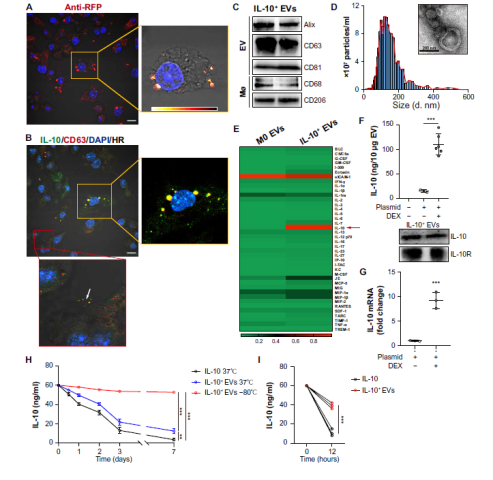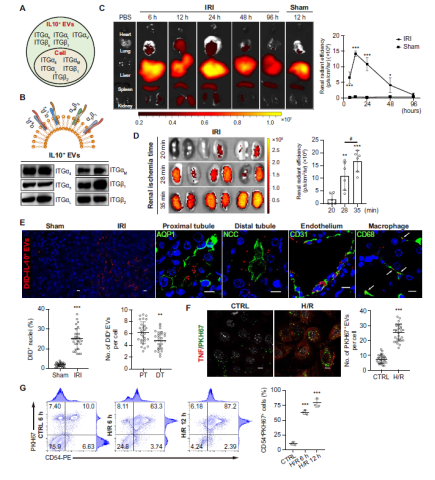In the treatment of acute kidney injury (AKI), extracellular vesicles (EVs) can be used as natural drug delivery systems, which has attracted strong research interest. A recent study by a group of research scientists (Tang et al.) from the Institute of Nephrology, Southeast University School of Medicine, Nanjing, China reports an approach to manufacturing interleukin-10 (IL-10)–loaded EVs (IL-10+ EVs) by engineering macrophages for treating ischemic acute kidney injury.

In AKI, studies have shown that Interleukin-10 (IL-10), a powerful immune modulator, can protect against ischemia, cisplatin, or ureteric obstruction–induced renal injury by limiting inflammatory cytokine production and immune cell infiltration[i], [ii]. Hence, IL-10 may be a potential therapy to tackle the current clinical challenges of AKI treatment. Cytokines are susceptible to chemical and physical instability[iii] which can lead to patient harm or reduced therapeutic efficacy; hence it is required to improve IL-10 stability and selectively target the injured kidney.
EVs have a natural origin, which enables them to evade phagocytosis, extend the half-life of the therapeutic agent, and reduce immunogenicity[iv],[v]. This research finds an EV-based drug delivery system may be an attractive candidate to manipulate IL-10 for the effective treatment of AKI.
This research study reported an effective method for preparing IL-10– loaded EVs (IL-10+ EVs) that were derived from macrophages. The research also investigated the therapeutic efficacy of IL-10+ EVs in a murine model of ischemic AKI.
IL-10+ EVs were able to enhance the stability of IL-10 and effectively target the injured kidney due to the adhesive components including integrin on the EV surface. Treatment with IL-10+ EVs significantly ameliorated renal ischemia/reperfusion (I/R) injury and prevented the AKI to CKD transition by targeting not only macrophages in the tubulointerstitium but also tubular epithelial cells (TECs) in the kidneys.
IL-10+ EVs suppressed mammalian target of rapamycin (mTOR) activity and consequently promoted mitophagy to maintain mitochondrial fitness in TECs. The research findings thus supported the use of EVs as a versatile delivery system for IL-10 and it was also found as an effective strategy for the treatment of ischemic AKI.
The steps involved in the preparation and characterization of the IL-10+ EVs are shown in Figure 1.

Figure 1. Preparation and characterization of the IL-10+ EVs.
The research finds that in the treatment of AKI, targeting IL-10 more specifically to the injured kidney should provide therapeutic benefits (Figure 2).

Figure 2. Kidney targeting of IL-10+ EVs.
To evaluate the therapeutic efficacy of IL-10+ EVs, a murine model of renal I/R injury was used, and IL-10+ EVs were administered intravenously after reperfusion and continued every 24 hours for 3 days.
Next, the study investigated the mechanism by which treatment with IL-10+ EVs ameliorated renal tubular injury. IL-10+ EVs inhibited mTOR signaling and induced mitophagy in cultured TECs in vitro. The data also clarified that IL-10+ EVs can promote mitophagy in tubular epithelial cells (TECs) both in vivo and in vitro.
The research found that IL-10+ EVs protect against tubular injury by inducing mitophagy to maintain mitochondrial fitness.
It was observed that IL-10+ EVs efficiently drive M2 macrophage polarization, which can suppress inflammation and promote kidney repair.
Next, the study examined IL-10+ EVs toxicity on the major organs, including the heart, liver, spleen, and lung. The histological analysis showed no evidence of in vivo toxicity of IL-10+ EVs.
This study reported an approach to manufacture IL-10+ EVs and assessed the feasibility, safety, and efficacy of IL-10+ EVs in the treatment of ischemic AKI. Impressively, delivering IL-10 by EVs enhanced both the stability of IL-10 and its targeting to the injured kidney. This resulted in notable renoprotective effects, specifically by promoting mitophagy to maintain mitochondrial fitness in TECs and driving M2 polarization of tubulointerstitial macrophages. The research findings suggest that IL-10+ EVs constitute an effective nanotherapeutic for the treatment of AKI.
References and Citations:
[i] J. Deng, Y. Kohda, H. Chiao, Y. Wang, X. Hu, S. M. Hewitt, T. Miyaji, P. McLeroy, B. Nibhanupudy, S. Li, R. A. Star, Interleukin-10 inhibits ischemic and cisplatin-induced acute renal injury. Kidney Int. 60, 2118–2128 (2001).
[ii] Y. Jin, R. Liu, J. Xie, H. Xiong, J. C. He, N. Chen, Interleukin-10 deficiency aggravates kidney inflammation and fibrosis in the unilateral ureteral obstruction mouse model. Lab. Invest. 93, 801–811 (2013).
[iii] T. Lipiäinen, M. Peltoniemi, S. Sarkhel, T. Yrjönen, H. Vuorela, A. Urtti, A. Juppo, Formulation and stability of cytokine therapeutics. J. Pharm. Sci. 104, 307–326 (2015).
[iv] O. P. B. Wiklander, M. Á. Brennan, J. Lötvall, X. O. Breakefield, S. El Andaloussi, Advances in therapeutic applications of extracellular vesicles. Sci. Transl. Med. 11, eaav8521 (2019).
[v] T.-T. Tang, L.-L. Lv, H.-Y. Lan, B.-C. Liu, Extracellular Vesicles: Opportunities and Challenges for the Treatment of Renal Diseases. Front. Physiol. 10, 226 (2019).
Media Contact
Company Name: Index of Sciences Ltd
Contact Person: Stella Richards
Email: Send Email
Phone: +441442781196
Address:Kemp House 160 City Road
City: London
State: England
Country: United Kingdom
Website: https://www.science.org/doi/10.1126/sciadv.aaz0748
